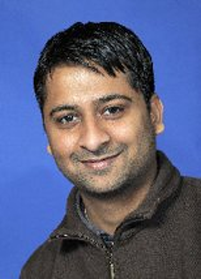Multiphase membrane contactors and reactors: Modeling and optimization study
Promotion date: 2. December 2011
Promotor: Prof.dr.ir. Rob Lammertink
Assistant Promotor: Prof. dr. ing. Matthias Wessling
| This thesis describes the study of multiphase contacting/reaction using porous membranes. The thesis mainly covers two parts; in the first part physical absorption of gas into the liquid is considered for different membrane geometries such as tubular and planar structures. The numerical and experimental studies show that by altering the geometry (helical hollow fibers for tubular channels) or surface topography (micropatterns on planar structures) of the porous membranes, it is possible to enhance the performance of the gas-liquid contacting module. The microgrooves on the planar membrane are created using phase separation micromolding methods. Later, these membranes are employed for gas-liquid contacting experiments to observe the effects of microgrooves on device performances. In the second part, detailed modeling and simulation of heterogeneously catalyzed reactions in tubular and planar geometries is considered. For the tubular geometries, removal of nitrites from water is considered as model reaction. Using modeling and optimization studies, optimum design and process conditions are found that gives improved microreactor performances. For planar geometries, photocatalytic degradation of methylene blue is considered. It was shown that the photoreactor performance is strongly influenced by the extent to which UV radiation is distributed across the photocatalysts. |
Was your thesis work application oriented?
In fact, my research work focuses on both application and fundamental research based problems. Membrane based gas-liquid contacting and reactions offer sustainable solutions to new applications that require less energy consumption, simple operations and improved performances. Such benefits attracted attention to many industries that aim for novel process routes and process intensification.
A study of multiphase contacting systems also involves fundamental understanding of hydrodynamics and mass transfer at the microscale. To aid in the design of such devices, we performed detailed numerical simulations of different geometries and sometimes experiments to validate our simulation results.
The modeling and optimization study of heterogeneously catalysed reaction systems covers two different cases: tubular reactors and planar reactors. In terms of relevance to applications, they can be used for water purification and photocatalytic reactions, respectively.
How did you develop personally as a scientist and researcher?
Honestly, when I started my PhD I was more of a theoretical person and still I enjoy doing fundamental studies. However, during four years of research, I understood that in order to support a theory, it is sometimes necessary to include well-planned experiments.
In this work, I have attempted to include experiments whenever there was a need. I also learned how to organize the research work that can lead to definite publication and relevance of the research work for specific applications. It was also an interesting experience to collaborate with colleagues from different disciplines.
Was there an important moment you recall during your thesis project work?
In the first year, we were discussing the features involved in this topic on many aspects. There were many ideas. Prioritization was necessary to draw a specific research plan. Eventually everything fell into place once I decided to focus on the specific systems and geometries I wanted to work on.
The chapters involving the use of micropatterns for flux enhancement, I look back upon as a decisive one. In some experiments, I have struggled using sensitive oxidation sensors and wetting studies. Also, the optimization study of porous membrane microreactors was challenging.
Did you have some nice publications along the way?
For example the work on helical membrane micromixers was published in the Journal of Membrane Science and another four publications in peer reviewed journals are yet to come. I also attended many national and international conferences. Internationally, I had an outstanding research paper reward at the Euromembranes conference in France. I also presented my work at the International Microreaction Technology (IMRET) conference in Japan.
What are your future plans?
Right now, I am working as a process specialist at Sabic Innovative Plastics in Bergen op Zoom, Netherlands. I am involved in the Technology and Innovation department to assist on various process intensification projects within the company. The knowledge and skills that I gained during my PhD will be very useful in my new job which requires working in a cross-functional environment.
How did you like being a member of the Mesa+ institute?
I was enjoying the monthly Mesa+ colloquia very much so and hardly missed one. Particularly the unique combination of talks of international renowned scientists together with young researchers from the Twente University itself was always very stimulating to me. I also enjoyed the yearly Mesa+ meetings which always bring very useful gifts at the end.
I always felt connected to Mesa+. The research atmosphere is vibrant combined with friendly and skilled colleagues whom I start to miss already.

